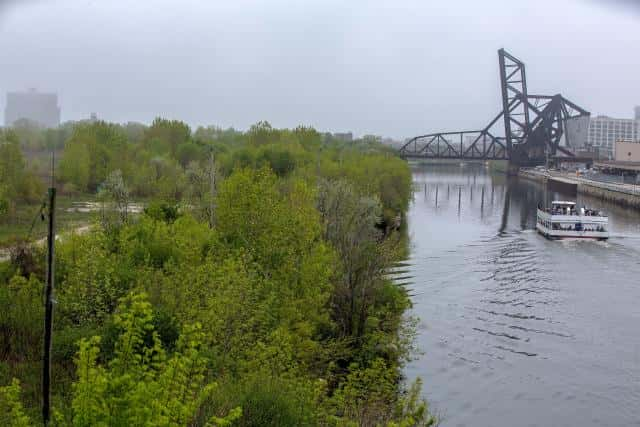Chicago has transferred nearly $140 million from secret public bank accounts to pay for infrastructure improvements in and around the two largest ongoing development projects in the city—one on the North Side and the other just south of the Loop—in a series of covert financial maneuvers.

Some infrastructure work may now be funded by taxes from nearby TIF districts
According to records, money has been progressively moving into place since 2020 for the renovation of the North Branch of the Chicago River, known as Lincoln Yards, and the development of a new neighborhood known as The 78.
In a report from Chicago Tribune, roads and bridges within and around both complexes will be built and improved with public funds. Although the use of tax increment financing money was always anticipated to be a part of both projects, it appears that some infrastructure work may now be funded by taxes from nearby TIF districts rather than the TIF districts that the city recently created to support the Lincoln Yards and The 78 projects.
The actions could be advantageous for Lincoln Yards given that the $6 billion project’s developer, Sterling Bay, has had difficulty acquiring funding. In addition, some of the TIF transfers allow the city to pay upfront costs for parts of the new infrastructure rather than Sterling Bay, which was the case under earlier plans, which called for Sterling Bay to pay for the infrastructure work up front and be reimbursed with TIF monies later.
The transfers came as a surprise to a TIF specialist who had been closely following the project because none of the three aldermen whose wards touched or covered the Lincoln Yards construction were aware of them.
The $139.8 million transferred from the adjacent TIF districts to the TIF districts established for the megadevelopments could have been split among all significant taxing bodies in the city, including for schools, libraries, and parks. The transfers did not occur in a vacuum, though.
Michele Smith, a recently retired alderman of the 43rd Ward, which borders Lincoln Yards and an opponent of utilizing taxpayer funds to assist the construction, admitted that she was aware that there was money in the nearby TIF districts but had no idea the transfer was for such a “outrageous” amount. She added that it went against her assumption that Sterling Bay would begin the project that the city might use the funds for infrastructure needs.
According to city authorities, the funds are primarily used to fund TIF projects that were left unfinished after they were allowed to expire. The developers in charge of such massive projects claim that not a single TIF cash has yet been returned to them.
TIFs have always been crucial to the development of Lincoln Yards.
READ ALSO: Chicago Income Tax Proposal Gains Support Amidst Revenue Challenges
$86 million from other TIFs has continued to flow
Reports from AOL stated that construction on the project began in 2021 after Sterling Bay received clearance in 2019. Sterling Bay claimed that it would help pay for road, bridge, and river wall improvements and be reimbursed over time by funds from the recently formed Cortland/Chicago River TIF district when it pitched the public and aldermen on creating an up to $1.3 billion mega-TIF to help cover the costs of renovating the congested area.
New or upgraded bridges at Armitage Avenue, Dominick Street, and the extension of The 606 into the Lincoln Yards area were among the projects that Sterling Bay intended to fund. The confusing Elston-Armitage-Ashland-Cortland crossroads was also supposed to be realigned. According to the city’s Department of Planning and Development, the development company would be qualified for reimbursement for up to $498 million of that work under the terms of Sterling Bay’s redevelopment agreement with the city.
According to city records, the Cortland/Chicago River account has only accrued an incremental $12 million. A bio sciences office is the only structure on the campus’ 53 acres that has been finished thus far. According to Crain’s, who also reported that the Chicago Teachers’ Pension Fund decided against participating in it, firm CEO Andy Gloor has cited the previous government of Mayor Lori Lightfoot as the cause of delays and the company has sought new financing to assist with the initial infrastructure investment.
However, the $86 million from other TIFs has continued to flow. According to annual reports created by DPD, which oversees the city’s TIF program, starting in 2020, tens of millions of dollars will be transferred from two adjacent TIF districts—North Branch North and North Branch South—into the Cortland/Chicago River account, reports USA TOPNews.MEDIA.
More than $12 million was allocated for the Elston-Armitage-Ashland-Cortland project; $1 million was set aside to study the creation of a new park and nature preserve; and $53 million was transferred to repair the bridges that cross the Chicago River on Webster Avenue and Cortland Street. Additionally, $20 million was designated for broadly funding the Lincoln Yards infrastructure redevelopment agreement, which DPD officials said will go for the Elston intersection project.
READ ALSO: Chicago Seniors Receive Lower SNAP Benefits Following Changes In Work Requirements




